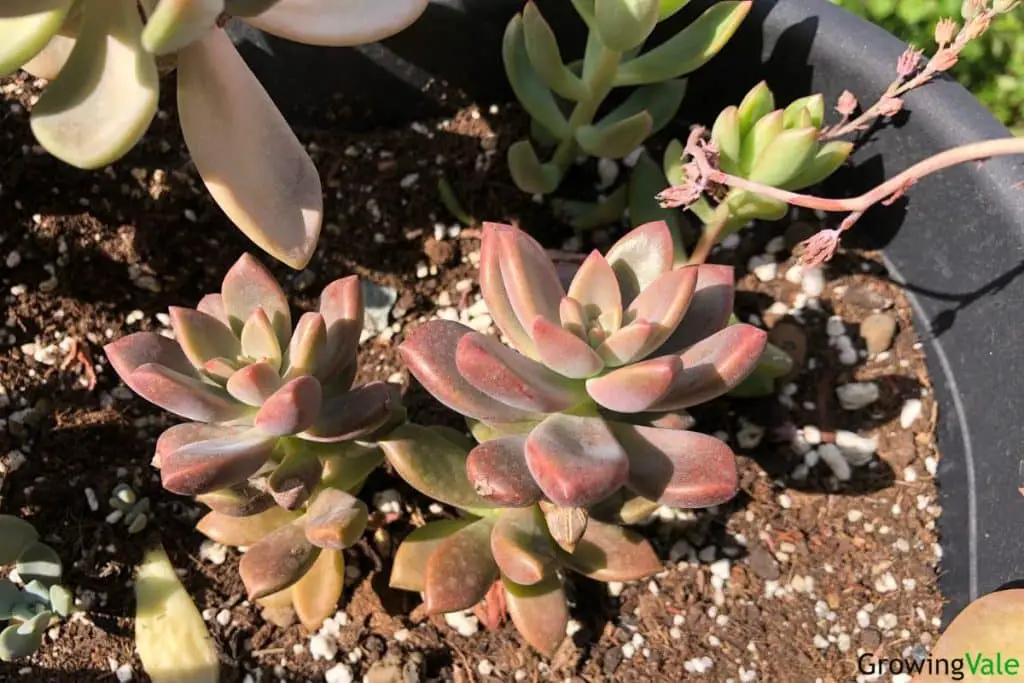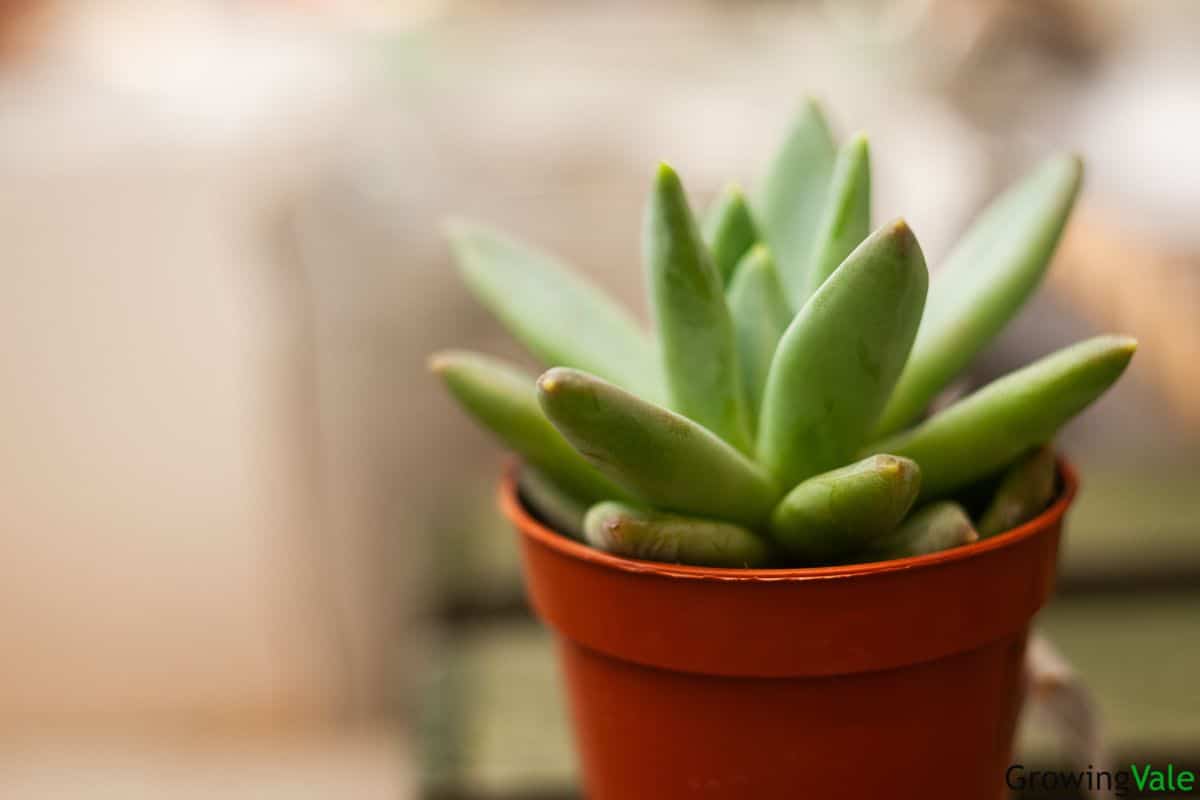All Graptosedum succulents are hybrids by crossing two other succulent species. You may also see them shown as xGraptosedum. The “x” signifies that the plant is a hybrid cross and not a pure species that can be found in a native habitat.
In general, Graptosedums are a cross between species from the Graptopetalum genus as well as the Sedum genus.
Because these plants are hybrids, there are only a limited number of cultivars. However, they vary greatly in color and all have the lovely succulent rosettes that grow on extended stems.
You’ll find that most varieties like to sprawl so they make great groundcovers if you have an outdoor succulent garden or live in a relatively mild climate. This sprawling habit also makes them great for hanging pots or large planters that sit on top of a pedestal.
Like most succulents, these plants put on most of their growth in spring and fall and are usually dormant over winter.
History
There’s very little information on the history of these plants. That’s because they’ve been created by commercial growers or backyard enthusiasts by crossing certain Graptopetalum species with species from the Sedum genus to create plants that have the best features from both genera.
Graptosedums are the result of this cross and were mainly bred because of their sprawling ability that enables them to be great ground covers. Of course, you have to live in a warm climate to be able to grow these delightful succulents outdoors.
The only fact that we can probably attribute to these varieties is that they were most likely created by those growers or enthusiasts for whom they were named.
For example, it appears that xGraptosedum ‘Francesco Baldi’, was most likely accidentally created by Dr. Francesco Baldi who was an Italian chemist and an active member of the Sedum Society.
Plant Facts
| Scientific name | xGraptosedum |
| Common names | None known |
| Genus | xGraptosedum |
| Family | Crassulaceae |
| Height | Up to 12 inches (30 cm) |
| Width | Up to 9 inches (23 cm) |
| USDA Plant Hardiness Zone | 10a to 11b |
| Origin | Cultivated hybrids |
| Flower colors | White |
| Blooming season | Spring |
| Plant/Flower special features | Hybrid plants that are easy to propagate from leaves, offsets and cuttings. |
How to Plant and Grow Graptosedum
Graptosedums can be grown in pots indoors or outside if you live in a mild climate. Ideally, you want to select a nice terracotta pot with good drainage holes.
Terracotta is porous so the soil is unlikely to hold much moisture for long. You can use other types of pots as well but just make sure that they have drainage holes.
When selecting a pot size, choose one that is just slightly larger than the rootball of the plant. You don’t want to have too much excess soil that might hold extra moisture.
When grown this way, you should only have to repot your succulents once every two or three years. Just choose a pot that is only slightly larger than the current one.
If you live in a mild climate and want to grow your succulent outdoors, make sure that the soil is very free-draining. A sandy soil is usually best.
If you have any concerns about the drainage of your soil, it’s a good idea to create a mound that you plant your Graptosedum onto. This will increase the drainage and your plant won’t become waterlogged.

How to Propagate Graptosedum
Because Graptosedum succulents are all hybrids, they can only be propagated using vegetative material and not seeds. However, these plants are easy to propagate using leaves, offsets and cuttings.
Here’s a brief explanation of how to propagate new plants using all these methods.
Propagation Using Leaves
- Remove some healthy leaves from the plant that are not blemished or wrinkled.
- Ensure that you remove an entire leaf close to the stem.
- Put these leaves into a warm, dry spot for two or three days. This allows the cut end to form a callus.
- Prepare some small pots or a seedling tray by filling it with succulent or seed-raising mix.
- Plant the leaves into the mix, cut side down.
- Spray the soil lightly to dampen it and place the cuttings in a warm spot that receives filtered sunlight.
- Make sure you mist the soil at least once a week to keep it slightly moist. It shouldn’t be allowed to dry out completely.
- It will take a few weeks for the leaf cuttings to produce roots and new growth. You’ll see evidence of this when a tiny rosette starts to form at the base of the leaf.
- When the original leaf starts to shrivel up, it can be removed and the new plant can be potted up into its own pot.
Propagation Using Offsets
- Select some offsets that have formed at the base of the plant and that are around a quarter of the size of the parent plant.
- Serve these offsets from the main plant carefully, ensuring that you keep any roots intact.
- Leave these offset in a warm, dry spot for a couple of days.
- Meanwhile, prepare some small pots by filling them with a succulent mix.
- Plant the offsets into the new pots and put them in a warm spot without watering them.
- After 4 or 5 days, you can water the soil but make sure that the excess water can drain away freely.
- Keep the plants in a bright spot that receives filtered sunlight and continue to water every 4 or 5 days.
- Once you see evidence of new growth, you can treat these new plants the same as the parent plant.
Propagation Using Cuttings
- You can take cuttings from your Graptosedum simply by severing some of the longer stems from the main plant.
- When taking these cuttings, make sure that you have around 1.5 inches of stem below the actual rosette.
- Leave these cuttings in a warm, dry spot for about 3 days. This allows a callus to form on the cut part of the stem.
- Meanwhile, fill some small pots with suitable succulent mix.
- Plant the cuttings, stem side down, into the mix in the pots.
- Do not water for about 7 days.
- After a week, you can water the soil in the pots, making sure any excess water can drain away.
- Keep your cuttings in a warm, bright spot that receives filtered sunlight and water once a week.
Graptosedum Care and Maintenance
Graptosedums are low-maintenance plants that don’t require a lot of attention. They love a nice bright spot, watering only when the soil has dried out and a small amount of fertilizer during the growing season.
Here are some basic succulent care tips to follow:
Soil
Graptosedums grow best in a well-drained soil that has plenty of grit added. In general, a commercially produced succulent or cacti mix will work very well. You can even add a little more perlite to the mix to increase the drainage.
Water
Graptosedum is no different to most other succulents. It needs to dry out in between watering otherwise the leaves, stems and roots will become waterlogged and rot will set in.
In summer, you should only have to water your plant once a week. Check the top few inches of soil with your finger and if dry, you can give your plant some water.
You’ll also notice when your plant needs water because the lower leaves will start to wrinkle slightly because their stored water has been used up by the plant.
During winter, your plant will be dormant. This means it will usually only need a drink once every 3 or 4 weeks. Once again, test the soil before watering the plant. It should be completely dry.
Most importantly, only water the soil that your succulent is growing in and avoid getting any water onto the leaves or the rosettes. Any water that sits on or in the rosettes will lead to rot. If you’ve accidentally splashed some water onto the leaves, just wipe it off with a soft cloth or tissue.
Fertilizer
While all plants benefit from an application of fertilizer, you don’t have to give your Graptosedum too much. Most importantly, use a liquid or succulent fertilizer but always dilute it to half strength. This can be applied once or twice during spring.
Sunlight
You’ll get the most stunning colors from your Graptosedum leaves if the plant receives around 6 to 7 hours of morning sunlight per day.
If you’re growing this plant indoors, choose a south-facing window to ensure that your succulent gets plenty of light. A good tip is to rotate your plant regularly so that all sides get a good amount of bright light.
This is particularly important if you want to promote nice, tight-growing rosettes. If your plant doesn’t get enough light, the stems will start to etiolate.
This basically means that the stems stretch toward the light and the space between the leaves gets larger. Essentially, this means that you’ll lose the nice rosette shapes that these plants are popular for.
You also want to make sure that you acclimate your succulents to the bright light. This is especially important if you’ve just purchased it from a garden center and it’s been living in a shade house.
Just expose the plant to the sunlight in small doses to begin with and then continue to extend the time gradually day by day. This will stop the leaves from getting burned from too sudden an exposure to direct sunlight.
Temperature and Humidity
Graptosedum succulents respond best when grown in hot, dry climates at temperatures around 65 to 75 degrees Fahrenheit (18 to 24 degrees Celsius). These plants are not cold-tolerant and should not be exposed to temperature below 30 degrees Fahrenheit (-1 degrees Celsius).
Although these plants can handle a little humidity, too much can cause them to rot. Therefore, you shouldn’t keep your succulents in areas that receive a lot of humidity such as bathrooms and kitchens. They’ll do much better in drier rooms in your home.
Pruning
Although these succulents don’t require regular pruning, it is wise to give them a trim if the stems get too long or lanky. Remember that you can use any material that you cut from the plant to propagate new ones.
Pest and diseases
Like most succulents, Graptosedums don’t have a huge problem with pests and diseases. However, you may find that plants grown indoors may have an occasional problem with mealybugs.
To control these, just dab them with a cotton bud moistened with isopropyl alcohol. This will kill the bugs instantly. You can also add some alcohol to the water before watering the soil as this will help to kill any eggs that may be present.
The only other problem you have to watch out for is rot. This is mainly only a concern for overwatered succulents. To avoid this, make sure that you never overwater your plant and that any excess water can easily drain away.
Uses of Graptosedum
Graptosedums are grown for their ornamental value and make great houseplants. They’re also good to use as ground covers in areas that only experience mild winter temperatures.
Common Varieties and Cultivars
As these plants are hybrids, there are only a small selection of Graptosedum varieties and cultivars available.
- xGraptosedum ‘Vera Higgins’
- xGraptosedum ‘Bronze’
- xGraptosedum ‘Ghosty’
- xGraptosedum ‘California Sunset’
- xGraptosedum ‘Francesco Baldi’
- xGraptosedum ‘Francesco Baldi Cristatum’
- xGraptosedum ‘Darley Sunshine’
- xGraptosedum ‘Blue Giant’
Conclusion
Graptosedum succulents are delightful, easy care plants that require minimal maintenance and are both easy to grow and propagate. These plants are hybrids produced by the crossing of Graptopetalum species and a variety of different Sedum species.

